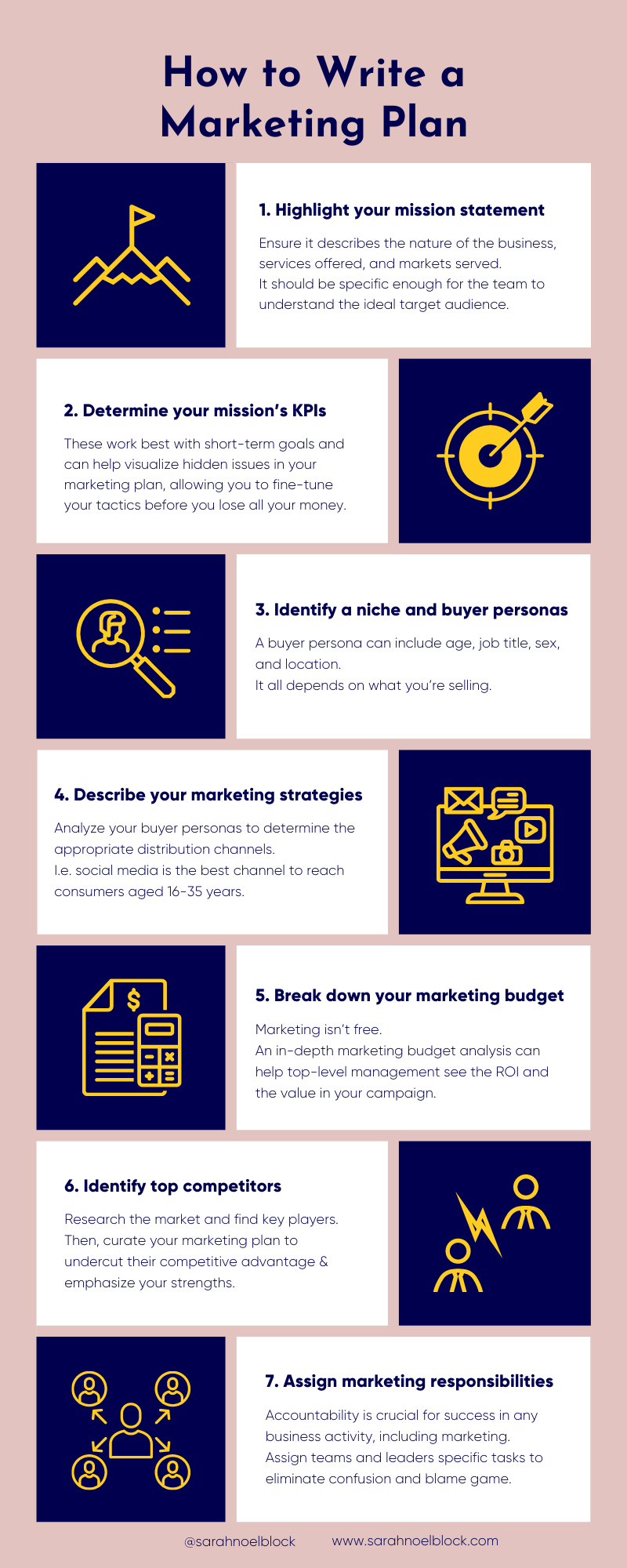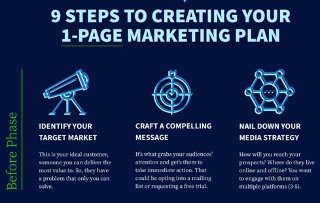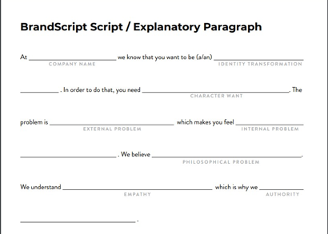Marketing Plan Examples and How to Write a Winning One
Table of Contents Show
Why are some marketing campaigns more successful than others? According to CoSchedule, marketers who actively plan their marketing strategies are 331% more likely to succeed than their peers. Goal setting also determines the success or failure of marketing initiatives. Another survey found that goal-setters are 4 times more likely to succeed. The message is clear. Craft a comprehensive marketing plan with realistic goals to deliver desired marketing results.
A marketing plan is the cornerstone of a successful marketing strategy. It can spark interest in your product or service, increase brand awareness, and support sustainable business growth. This guide covers everything you need to know about marketing plans. We’ll discuss how to write a marketing plan and analyze the best examples. But first, what is the difference between a strategy and a plan?
Marketing Strategy vs. Marketing Plan
Although "strategy" and "plan" are often interchangeable, the terms don't have the same meaning. Marketing teams need both a marketing plan and a strategy to answer the why, what, when, how, and where. All five are crucial for success.
A marketing strategy highlights the campaign goal, ensuring all stakeholders are on the same page. It aligns marketing activities to the company’s mission and marketing goals and visualizes the deliverables for team members.
A marketing plan is a strategic roadmap that allows you to organize, execute, and track a marketing strategy or campaign over a specific period. It visualizes how your team will accomplish the business and campaign goals highlighted in the marketing strategy. You can also use your marketing plan to establish a timeline and prioritize marketing activities.
Your strategy and plan will link to the marketing mix’s 7Ps: product, promotion, price, place, people, process, and physical evidence. You can customize your marketing plan to address unique business goals. For example, a marketing action plan outlines the sequence of activities needed for your strategy to succeed. It’s more detailed than a strategic marketing plan. So you should write your marketing plan based on your marketing strategy to align all activities with overall marketing and business goals. How to get started?
How Do You Write a Marketing Plan?
Writing a marketing plan is one of those things that seems daunting until you try it. First, analyze your marketing strategy to understand the link between business goals and the campaign. Then, craft a marketing plan to organize the tactics to achieve these goals. Your plan should define the what, when, how, and where to keep your team on track throughout the campaign. It should also help you measure the success of your marketing strategies and activities. Once you’ve nailed these aspects, start writing a marketing plan.
Note that the step-by-step process varies depending on the type of marketing plan. For example, quarterly marketing plans require time-specific strategies and milestones. You must achieve your campaign goals before the quarter lapses. Social media marketing plans focus on the channels and tactics, while content marketing plans are more content-oriented. Here are the seven steps of writing a marketing plan:
1. Highlight your mission statement.
State your company’s mission, then link it to the marketing campaign. For example, the company's mission is "to deliver world-class tour and travel experiences." In this case, your marketing mission might be "to increase brand awareness in the tourism sector, attract tourists and travelers, and convert them into customers." Ensure your mission statement describes the nature of the business, services offered, and markets served. It should be specific enough for the team to understand the ideal target audience.
2. Determine your mission’s KPIs.
The second step of writing a marketing plan is to select key performance indicators (KPIs) to track your progress. Without KPIs, your team will be working blind. Ensure you use appropriate metrics to measure activities, initiatives, and other marketing elements.
If your campaign’s mission is to attract potential customers to the company’s website, use Organic Page Views as your KPI. This metric can help you monitor changes in the number of site visitors. Remember, KPIs work best with short-term goals. They can help visualize hidden issues in your marketing plan. This means you can fine-tune your tactics before you lose all your marketing dollars.
3. Identify your niche and buyer personas.
In this section, describe the target audience for your product or service. Segment the consumer market and create a buyer persona by defining the ideal customer for your offering.
A buyer persona can include age, job title, sex, and location. It all depends on what you’re selling. For example, buyer personas for business software solutions only require the job title such as CEO, CFO, CTO, IT Manager, or Marketing Director.
4. Describe your marketing and promotional strategies.
Allocate more time to this section because it is the most crucial segment of your marketing plan. Here, you'll describe your marketing strategies, channels, and goals. According to HubSpot, 82% of marketers use content marketing. And 60% of the marketers measure the success of their content marketing strategy through sales. Will your team create blogs, videos, or infographics? A recent survey found that successful marketers use social media ads, email marketing, and blogging.
Analyze your buyer personas to determine the appropriate distribution channels for your content. For example, social media is the best channel to reach consumers aged 16-35 years. So hit your target audience with short videos on TikTok and photos on Instagram.
5. Break down your marketing budget.
Marketing isn’t free. As a marketing director, you understand the challenges of seeking additional funds from top-level management. Use your marketing plan to justify why the company should spend scarce financial resources on your campaign. Create a budget section on your plan and break down the cost of each marketing activity, from content creation fees to paid ads and sponsorships. Countercheck all items to find cost-cutting opportunities: for example, leverage free social media marketing channels to reduce expenses. An in-depth marketing budget analysis can help top-level management see the ROI and the value in your campaign.
6. Identify top competitors.
Your marketing plan won’t be complete without mentioning the competition. Research the market and identify the key players. Then, create a profile for each rival. List competitors based on what you're marketing or your campaign goals. The idea is to identify fertile poaching grounds. Profile competitors who offer what you're selling. Then, curate your marketing plan to undercut their competitive advantage. Emphasize your strengths.
7. Assign marketing responsibilities.
Accountability is crucial for success in any business activity, including marketing. Your marketing plan should indicate who's doing what. Assign teams and team leaders specific tasks to eliminate confusion and blame game.
What Are the Four Main Components of a Marketing Plan?
Marketing plans vary in terms of layout and content. It all depends on your marketing strategy. If you need to review goals every 90 days, you'll have to create an actionable quarterly marketing plan. However, each marketing plan has four main components.
Target Market
Your marketing plan should be customized to a well-defined target market. No one wants to waste scarce financial resources targeting the wrong audience. Each product or service was developed with a specific market segment in mind. So, your marketing plan should focus on appealing to the intended target. Collaborate with department heads and top-level management to ensure your campaign targets the ideal niche and customer. For example, product development teams can help streamline market segmentation and content creation.
You can't target everyone with a single marketing campaign. For example, your company offers petrol and electric cars, but your marketing plan focuses only on electric vehicles. I bet some team members will want to market both petrol and electric cars, wasting time and resources. To avoid confusion, define your plan’s omissions. Based on the example above, you’ll have to omit the non-electric auto market from your marketing plan. Omissions ensure your team focuses only on the target market of that campaign.
Differentiation
At its core, businesses undertake marketing campaigns to outperform the competition. Each niche has a specific number of consumers. You cannot create customers out of thin air. You can only market your products and poach some customers from competitors. And it all boils down to differentiation. What makes your product or service stand out from the crowd?
Why is your company’s offering better for the consumer than the competition? Repeat the answers to these questions creatively until the target customer sees the value in your product or service. You can differentiate from the competition based on price, technological innovations, customer service, and product features. Combine several strategies in your marketing plan to proclaim your unique position in the marketplace to the target audience. Read the analysis of Lyft’s marketing plan formula below to understand the power of differentiation.
Budget
Although marketing is crucial for business growth, it should be undertaken on a defined budget. Top-level management provides financial requirements. Then, marketing directors propose a budget for their campaign.
Example: Lush’s marketing budget (calameo.com)
Your marketing plan should provide a detailed breakdown of how and where allocated funds will be spent. How much money will you need for promotional merchandise, for example? Then, break down this expense into its core components. This could be $10,000 for creating t-shirts and hats to give to target consumers during your marketing event.
Price Strategy
Pricing is the most influential differentiator in the marketplace. So, your marketing plan has to provide a well-defined pricing strategy for what you’re selling. For example, you can leverage penetration pricing to poach some customers from the competition. But this strategy is only recommended for businesses that can afford to lose money. Also, it doesn’t work for high-end products or services. If you’re marketing a luxury brand, use skim pricing to capture affluent customers. Include marketing psychology in the pricing process to entice the target consumer.
Seven Marketing Plan Examples
The main idea behind marketing campaigns is to grab consumers’ attention long enough to make your case. But this is easier said than done for inexperienced marketers. Fortunately, you can seek inspiration from industry leaders and resource providers in the marketing sector. Here are the best marketing plan examples with resources:
1-Page Marketing Plan
Writing a marketing plan is challenging for first-timers. Successwise decided to help out marketers by introducing its 1-Page Marketing Plan. The canvas offers one of the easiest and fastest ways to create a marketing plan for business growth. It has nine steps divided into phases: Before, During, and After.
Focus on capturing, nurturing, and converting leads in the second phase. Download the free 1-Page Marketing Plan and use this template to take your product or service to the next level.
Successwise’s marketing plan canvas is based on The 1-Page Marketing Plan book by Allan Dib. It simplifies creating a marketing plan, transforming beginners into marketing heroes. After reading this book, you'll be able to craft your own sophisticated marketing plan from scratch.
5-Part Marketing Plan by StoryBrand
Business Made Simple’s (BMS) Donald Miller and Dr. J. J. Peterson created a step-by-step StoryBrand guide to simplify marketing for businesses. The 5-part marketing plan is a comprehensive template with a well-defined layout. Here are five sections of this simplified marketing plan:
Part 1: Write a compelling one-liner.
Part 2: Lay out your website in designated sections, including header, stakes, guide, value proposition, 3-step plan, video, and price choices. It also provides an explanatory paragraph section with a customizable BrandScript Script at the bottom of the marketing plan.
Part 3: Write your lead generator, starting with a compelling title.
Part 4: Craft a customized nurture campaign.
Part 5: Write your sales campaign emails. The template provides six sections for emails, including Deliver the Asset, Problem + Solution, Testimonial, Overcome Objection, Paradigm Shift, and Sales.
The 5-part marketing plan provides guidelines at the bottom for meeting agendas to help you write each section. You can also use a sample wireframe attached to the template to streamline Part 2.
Anyone can download StoryBrand’s 5-part marketing plan and use this template to create a sophisticated marketing plan quickly and easily.
BMS offers tons of resources and courses to help businesses simplify their marketing efforts. After completing BMS’s Marketing Made Simple course, you'll be able to create a marketing plan with a sales funnel for your business. To learn more, watch this course video.
Forrester Marketing Plan-on-a-Page
One of the biggest challenges facing marketers is rounding out their marketing plans after determining campaign goals. Forrester’s Marketing-Plan-on-a-Page template helps you align your deliverables with business objectives. It transforms scattershot marketing plans by making your tactics more specific and focused. Using this template, you can visualize how your marketing activities fulfill overall business objectives.
Marketing activities are not meant to be independent or an end unto themselves. They should serve a big-picture purpose, aligned to campaign and business goals. Use Forrester’s Marketing Plan-on-a-Page template to ensure your marketing plan is guided by overarching objectives rather than rigid commitments to tactics. So, you’ll have the freedom to switch or refine your strategies to attain the desired results. This level of flexibility supports dynamic marketing planning. You can review your plan periodically and make the necessary adjustments to stay on target.
Forrester’s Marketing Plan-on-a-Page template allows you to align your marketing campaign with other functions. It breaks down silos to transform your marketing plan from a detached set of tactics to an integrated approach that drives business growth. Once you’ve determined your campaign goals, use Forrester’s Marketing Plan-on-a-Page template to round out your marketing plan. You can download Forrester’s Marketing Plan-on-a-Page template by clicking this link.
Gartner Marketing Plan 1-Pager
Gartner’s marketing plan provides a clear roadmap to deliver on your business goals. The 1-page template consists of three sections: Current State, Plan, and Future State.
Current State: Indicate the prevailing conditions related to the marketed product or service. For example, product X has a Net Promoter Score of +25. This metric shows the product's brand health. Use 4-7 metrics, like annual sales, to visualize the current state.
Plan: Write mission-critical components of the marketing plan in this 3-part section. In Part 1, indicate 4-7 marketing initiatives or campaigns. For example, implement targeted digital ads to boost brand awareness. Highlight 4-7 assumptions or requirements in Part 2 that will deliver your campaign goals from Part 1. In Part 3, capture the essence of your marketing plan by linking it to your marketing strategy and business goals.
Future State: Define the goals of each initiative and the KPIs to track performance.
Gartner’s Marketing Plan template links your marketing plan with the overall strategy and campaign goals. It delivers a clear and measurable marketing plan.
Lyft Marketing Plan Formula
How did Lyft conquer and gain traction in a sector dominated by Uber? Well, Lyft’s marketing plan formula answers this question. Lyft’s marketing strategy focuses on why it's different from Uber rather than claiming superiority over Uber. It proclaims Lyft’s uniqueness. For example, Lyft’s website highlights its drivers on every home page, while Uber puts the spotlight on their passengers. Lyft features more female drivers and passengers in its ads, creating a perception that Lyft is the safer option for women.
Lyft understands its target audience. Its site presents each ride as a new, unforgettable experience, enticing young consumers.
The Lyft experience is friendly and interactive. This branding message is reinforced by Lyft’s tagline, "Your friend with a car.” It creates a perception that interactive experiences are possible in a Lyft car. Lyft implemented an innovative marketing campaign known as Undercover Lyft to showcase the friendly side of its drivers. Check out this Undercover Lyft video.
Lyft’s marketing plan formula presents the company as a community rather than a ride-sharing service. The brand operates community.lyft.com, a site for Lyft drivers and dedicated fans. This website nurtures a sense of community and belonging.
Lyft carved out a piece of the ride-sharing market by identifying its audience, creating memorable experiences, and differentiating from Uber. As a marketer, learn from Lyft to create a marketing plan that drives business growth.
Dell Marketing Plan Formula
Dell offers end-to-end IT solutions for commercial and consumer markets. Its business goals include achieving qualitative and quantitative leadership, maintaining positive sales growth, and increasing product awareness and market share. To this end, Dell targets emerging economies and provides the best customer experience.
Dell’s marketing plan formula combines several strategies. The tech giant uses a pricing strategy by offering low to high-priced products. For example, Dell’s XPS is premium-priced and its Inspiron laptops are low-priced. This strategy caters to consumers from diverse financial backgrounds and increases Dell’s competitive advantage. The company also provides after-sales service to attract potential customers.
Dell spends millions of dollars on marketing and promotional campaigns, focusing on TV ads and print media. Its TV ads proclaim the brand's innovative products and their performance-related benefits. Although Dell has strong competitors like HP, Lenovo, and Acer, it has positioned itself as one of the top players through effective marketing.
Lush Marketing Plan
Lush is a cosmetics brand that manufactures beauty products from fresh, natural ingredients. The company created a comprehensive 12-part marketing plan to increase sales, brand awareness, and customer loyalty. First, Lush analyzes the cosmetics market and its product before highlighting its business values, mission, and vision.
Lush breaks down its marketing model and values matrix. The marketing plan also features Lush's SWOT analysis indicating its strengths, weaknesses, opportunities, and threats. (Check out its target market and competitors under Situational Analysis.) Lush's marketing strategy combines several approaches, including sensory marketing that taps all five senses to captivate customers.
Lush leverages social media marketing with the hashtags #GoFresh, #AgainstAnimalTesting, and #GoNatural to differentiate from the competition. Customers can create personalized cosmetics and beauty products based on their skin type via www.lush.pt.
Lush’s marketing plan includes a calendar, visualizing scheduled marketing activities and events. The beauty brand uses several controls to monitor its marketing budget to minimize spending and maximize profitability.
Conclusion
A marketing plan is the cornerstone of successful marketing campaigns. Planning brings together all your marketing strategies and initiatives and aligns them with business goals. You can rely on the seven steps to write a sophisticated marketing plan. Include the four components of an effective marketing plan – target market, differentiation, budget, and pricing strategy. Then, use the best marketing plan examples for inspiration.
Marketing is dynamic and ever-evolving. You’ll need a reliable partner like Tiny Marketing to guide you on your journey. We provide professional insights to help marketers navigate the complex marketing landscape. Join our weekly newsletter to stay up to date with the latest marketing trends.















